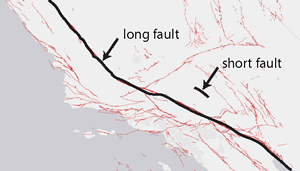
Earthquakes come in many different sizes which you generally hear described by their magnitude. The magnitude measures how much the ground shakes. There are other ways to measure the size of an earthquake, for instance we can measure how long the fault was that slipped during the earthquake.
In a band both trumpets and tubas can play at the same volumes or magnitude, but the smaller trumpet plays higher notes. For the same magnitude, a short fault will produce more high frequencies than a longer fault.
Below are two seismograms, or records of ground shaking, that you can listen to. They are from two different earthquakes that occurred near each other. Both earthquakes were recorded on the same seismometer and had nearly equal magnitudes, but they sound different. Click the sideways triangle (or play button) to hear the sound.
Earthquake One
Earthquake Two
Which earthquake had the shorter fault:
or ? Jump to Navigation
Jump to Navigation